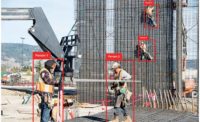Recent conversations with Autodesk’s technologists, a tour of Autodesk’s “Pier 9” workshop on the San Francisco waterfront and an encounter with Carl Bass, Autodesk president and CEO, builds an appreciation for the company’s deepening interest in 3D printing.
The workshop is a 27,000 sq ft, two-story structure housing 115 people on a pier near Autodesk’s San Francisco offices at the foot of Market Street. It opened last fall and has been equipped with offices, presentation spaces, a test kitchen, a Baskin Robbins ice cream parlor and a series of workspaces separately equipped for cooking, sewing, mixed crafts, product photography, metalwork, carpentry, CNC and waterjet machining and rows of 3D printers. The equipment is new, high-end and factory grade.
Autodesk employees are welcome to train to use its facilities and experiment with projects there. The company also has a visiting artists program that lets non-employees apply to use it too. Examples of complex and unusual 3D printing projects are everywhere, although there is plenty of other kinds of creative activity under way as well.
ENR ran into Bass while touring the place and asked him “Why Pier 9?”
“A whole bunch of reasons,” Bass said. “One thing that its really important for us going forward is that the workflow from when you have the idea about making something, to actually physically realizing it, is incredibly important.
“And so its important that all of the people that work at Autodesk understand what the process is for our customers, in going from an idea about a building or a road or an automobile, all the way to the finished goods. And then, very specifically, we actually make and sell software that helps people do fabrication. So this is our testing lab.”
An Autodesk spokesman, Bill Danon, elaborated further: “The purpose of the workshop is about how the software we make, which is all about design and digital models, can convert to the world of actually made things. Our software needs to interact with the tools—the C&C machines, the 3D printers—so we are exploring how we can improve the interfaces between the software and the hardware.
Jordan Brandt, a technology futurist on Autodesk’s Manufacturing 2020 Team also happened to be in the shop that day. Brandt says his job is to investigate trends and technologies that impact how people design and make things. He was with a group of about 30 developers and engineers, including Bass, who were watching a demonstration by Cambridge, Mass.-based MarkForg3D of the first carbon fiber 3D printer, unveiled in February.
In comments that day, and follow-ups, Brandt says Autodesk is making a commitment to support3D printing with moves to put its software and services—and now, as recently announced by Bass in a blog, even an Autodesk-branded printer—at the center of that industry.
Brandt described an intriguing relationship Autodesk has established with a Dutch company called 3D Hubs which has assembled a global network of nearly 5,000 subscribing 3D printers. Users can log into the network, select a printer location, upload files and pick up their finished work, usually within two days.
The 3D Hubs network is set up to use the STL file format, which Brandt says is not data-rich, but he says the printers Autodesk is preparing to bring to market later this year, with a open-source software to run them, will accept the much more sophisticated AMF (Additive Manufacturing File) format developed by the American Society for Testing and Materials, which Brandt describes as new, intelligent and data rich, and embedding 3D printing requirements, such as object, material, texture etc.
It is not yet clear how Autodesk plans to leverage its relationship with 3D Hubs beyond integrating the API in its design products so 3D printers can be found and jobs ordered from within the applications. But Brandt describes a potential scenario where scattered printers in multiple locations can be put to work on producing a batch of items for a single order, and be kept running, essentially around the clock in a distributed manufacturing system.
Brandt says the burgeoning 3D printing industry is an area that is "ripe for disruption." Innovations now being investigated include the production of a $1,000 laser printer using off-the-shelf components, and printing to a traveling bed, so larger—or at least longer—objects can be created. Another promise is in taking advantage of the printers' ability to create seamless transitions from materials of one property to another within a unified product, so one edge might be of a soft gasket material, and the other side hard and transparent. He suggests such products might be of particular use in curtainwalls, where mechanical interfaces between materials often are the source of problems.
This may be a breakout year for 3D printing technology.



Post a comment to this article
Report Abusive Comment